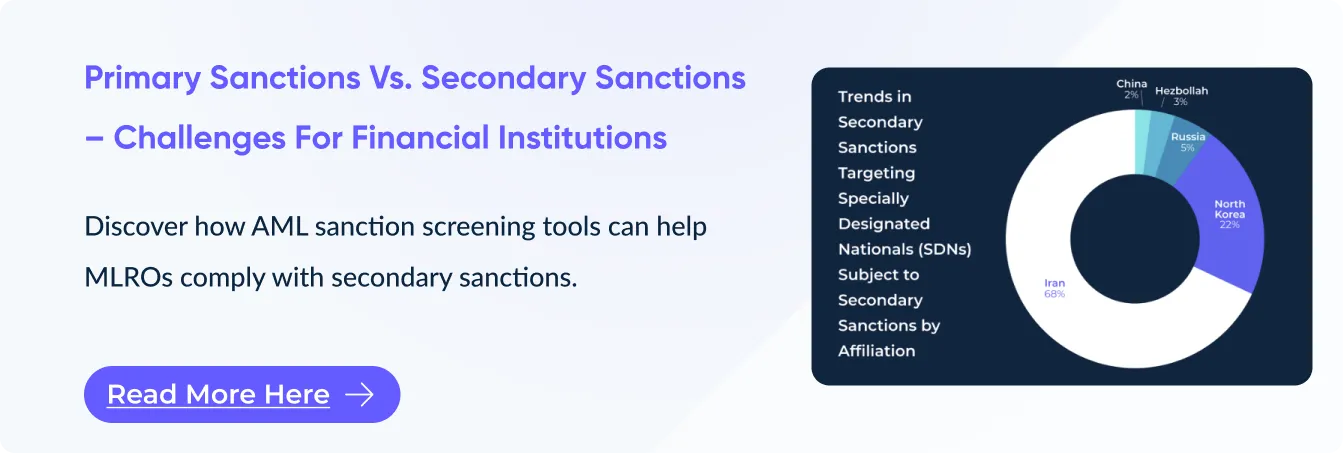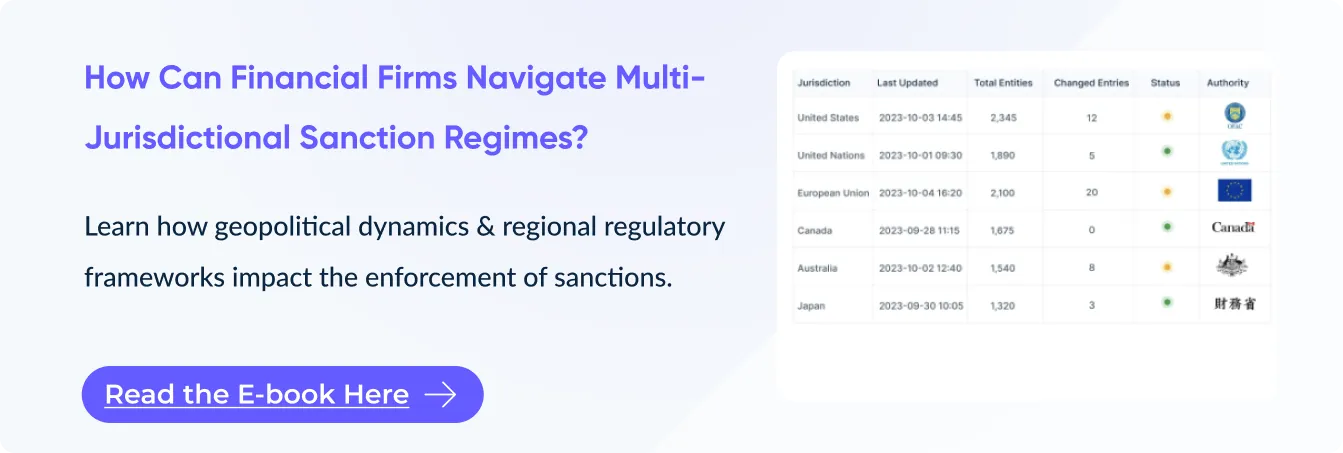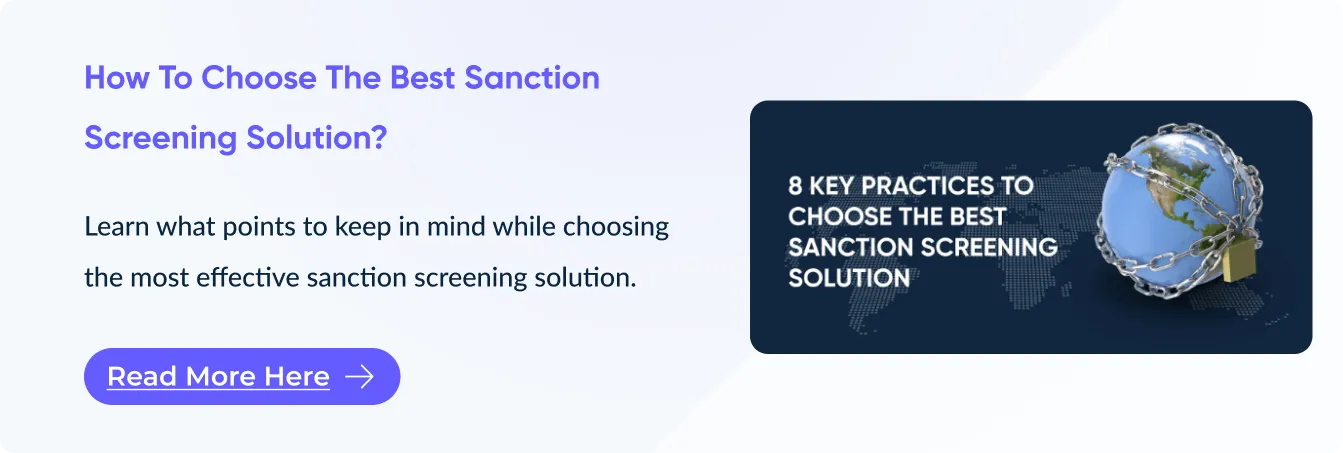
Understanding Sanction Screening: A Simple Guide
Over the past 5 years, the enforcement actions by the European Union have increased more than fivefold. This dramatic rise is caused by the aggressive imposition of sanctions following the Russian invasion of Ukraine.
As the sanctions regimes are becoming more complex, the financial industry is, therefore, is facing unprecedented pressure to optimize its sanctions screening processes and keep up with the ever-evolving regulatory landscape.
In 2024 alone, the European Union introduced 695 financial sanctions around the world, which further increased compliance challenges for financial organizations.
As the sanctions grow in number and complexity, sanctions screening solutions are now offering more advanced sanction screening tools that come with automation, global coverage, and data-driven risk detection.
More than ever, such sanction screening software often helps to reduce costs while maintaining regulatory compliance.
Sanctions imposed by the UNSC have larger implications, as all the member states of the UNSC are obligated to implement UNSC sanctions by freezing the assets of sanctioned individuals. All this is done so that the targeted entity cannot benefit from the international financial system.
One of the primary objectives of enforcing these sanctions is to prevent terrorist financing and money laundering. All designated non-financial businesses and professions (DNFBPs) and the financial industry are therefore prohibited from providing any financial service to the sanctioned entities.
Not adhering to the sanction screening protocol results in various legal penalties, be they criminal, civil, or administrative, against both entities and their senior management.
But before we discuss how the financial industry can cope with this challenge, let’s first learn what sanction screening really is, the types of sanctions in the contemporary sanction landscape, how sanction checks make a difference for the banking sector, and what sanction lists financial corporations must comply with.
What is Sanction Screening?
For any bank, investment firm, or insurance company, sanction screening meaning is a process of cross-checking potential clients (individuals, businesses, or organizations) against the domestic and international sanction lists and avoiding offering any financial services if they turn out to be sanctioned by the regulatory bodies.
Since financial institutions are at the forefront of engaging in financial crimes, they bear an inherent responsibility to play their part and prevent prevalent financial crimes like money laundering, terrorist financing, weapons, drugs & human trafficking, corruption, fraud, embezzlement, and many more.
Sanction screening is, therefore, one essential element of anti-money laundering and counter-terrorist financing (AML/CFT) frameworks, where financial institutions are obligated to comply with it or else face legal repercussions.
What is a Sanctions List?
Sanction lists include the lists of individuals, entities, and organizations that have been identified as a threat to security, financial stability, and the violation of international laws.
The sanction lists serve as a primary referral to ensure compliance in the niche of AML (Anti-Money Laundering) and CFT (Countering Financing of Terrorism).
Governments and financial authorities worldwide meticulously maintain public sanctions lists, each serving as a distinct facet of the complex regulatory landscape.
As MLROs are acutely aware, these lists are integral to the fabric of financial compliance and risk management.
Some prominent sanctions lists:
United Nations Consolidated Sanctions
The United Nations maintained the United Nations Consolidated Sanctions UNSC list for peace and security. It has included all individuals and organizations sanctioned by the United Nations Security Council.
European Union Consolidated Sanctions
The European Union Consolidated Sanctions list consists of individuals and organizations that are subject to financial sanctions in line with the EU’s foreign policy.
Financial sanctions show the asset freezing and prohibition for availing, and they couldn’t avail financial services from any of the financial institutions under EU regulations. All EU member states are obligated to comply with this sanction list.
U.S. Department of the Treasury, Office of Foreign Assets Control (OFAC) List
OFAC works under the U.S. Department of the Treasury, which oversees the enforcement and administration of the U.S. economic and trade sanctions programs imposed in line with U.S. foreign policy and national security goals.
OFAC may target individuals, groups, entities, regimes, and even entire countries that may be involved in terrorist financing, money laundering, drug trafficking, weapons of mass destruction proliferation, or violating international laws.
OFAC – Specially Designated Nationals (SDN) List
A list of individuals and entities banned from U.S. dealings.
OFAC – Foreign Sanctions Evaders (FSE) List
List of subjects that have been ignored and not abided by U.S. sanctions.
OFAC – Sectoral Sanctions Identifications (SSI) List
List targeting only chosen sectors within sanctioned countries. For example, finance, energy, etc.
UK Office of Financial Sanctions Implementation (OFSI)
The UK’s regulatory department for implementing and enforcing financial sanctions in line with the UK’s foreign policy. It works under the HM Treasury and assesses the sanction evasion cases, imposes penalties in case of violation, and monitors the enforcement of financial sanctions across all sectors in the UK.
Australian Department of Foreign Affairs and Trade (DFAT)
Australia’s DFAT is designated to collaborate with foreign partners and other countries to address global challenges, expand trade and investment opportunities, uphold international rules, maintain regional stability, and assist Australians abroad.
Swiss State Secretariat for Economic Affairs (SECO)
Switzerland’s authority for regulating economic sanction-related matters. It oversees the enforcement of the Swiss sanctions regime and updates it continuously.
Hong Kong Monetary Authority (HKMA)
Hong Kong’s central banking institution is to look for finance-related sanctions. The HKMA has been at the forefront of establishing AML/CFT systems and the enforcement of sanction screening protocols.
Singapore’s Monetary Authority of Singapore (MAS)
Singapore’s central bank and financial regulatory authority must sustain smooth procedures. It sets sanctions regulations and supervises the city’s banking, capital markets, and insurance sector.
Beyond the aforementioned regulatory authorities, there are numerous other country-specific sanctions lists, as each country maintains its own sanctions regime.
What is a Sanction Check?
When a financial firm compares the names of prospective clients (individuals, businesses, or organizations) with regional or global sanction lists to verify whether they are subject to prohibitions given their involvement in criminal activities that violate international laws.
Investment firms, banking sector, insurance companies, brokerages, real estate firms, and cryptocurrency exchanges are mandated to run regular sanction checks on their existing and prospective clients in line with Know Your Customer (KYC) or Know Your Business (KYB) protocols
What are the Types of Sanctions?
Sanctions are a set of regulations imposed by higher institutions to control and coerce the repetition of illicit financial behaviors to maintain peace and security.
Coverage of sanction types includes the following:
Economic Sanctions: Restrict trade across sanctioned countries. These sanctions can expand up to dismissing global relationships or may also target specific sectors.
Financial Sanctions: Bar financial transactions and restrict organizations from proceeding with foreign transactions.
Travel Sanctions: Restrict the entrance of a sanctioned individual into a territory or state to avoid security risks.
Diplomatic Sanctions: Driven to terminate diplomatic ties between the two parties. This may include withdrawing ambassadors, etc.
Sport Sanctions: Limit the participation of sanctioned parties in international sports events or championships.
Targeted sanctions: As the name suggests, they target only specific entities, individuals, or organizations within a defined boundary.
Sectoral sanctions: reflecting through the name, impose limitations on particular sectors of a company, for example, finance, military, state departments, etc.
Understanding the Process of Sanctions Screening
Sanctions screening stands as the foundation pillar to uplift AML/CFT controls. The process of screening begins with cross-checking an entity’s or client’s current standing with sanction directories from authorized regulatory bodies to ensure their current sanctioned status or risk profiles. The entire screening process can be decoded into three distinct stages.
- Name Screening: Prospective customers are screened against the global databases, specifically those related to criminal records, blacklists, and public records.
- Risk Profiling: A customer risk profile means conducting a systematic risk assessment of a client to determine the risks associated with them. Customers are divided across the low-risk and high-risk categories.
- EDD & Ongoing Monitoring: After the risk profiling, Enhanced Due Diligence is conducted on clients that are categorized as ‘high risk.’ Both low-risk and high-risk clients undergo ‘ongoing monitoring.’
Navigating Sanctions Compliance Challenges in the UK and BALTIC Region
Industries Obligated to Comply with Sanction Screening
Finance Industry: The finance industry includes various sectors such as banks, investment houses, insurance companies, real estate brokers, consumer finance companies, mortgage lenders, and real estate investment trusts (REITs).
All these sectors must screen their clients using sanction screening software to improve the efficiency of AML/CFT compliance. Moreover, cross-referencing with authorized lists is also crucial to prevent dealing with legal penalties caused by sanction evasion.
Maritime Industry: The maritime industry includes all the activities and sectors related to the sea and waterways, such as shipping, ports, shipbuilding, marine research, fishing, and tourism. Considering its contribution to global trade, the industry is looking to evade challenges related to deceptive shipping.
Therefore, this industry is also mandated to use sanctions screening by bodies such as the UN and OFAC with a mission to enable sustainable trade practices.
Aviation Industry: The aviation industry, which includes airlines, aircraft manufacturers, airports, and maintenance and repair services, is also mandated to comply with sanctions screening in AML. The need for sanction screening for aviation may seem unrelated, but it is highly undeniable.
Screening is crucial to detect sanctioned aircraft to prevent any dealings within restricted airspace or engagement in banned aviation-related activities.
Why Sanction Screening Should Be a Non-Negotiable for Your Business?
The main focal point of imposing sanctions is to mitigate the illicit actions of targeted individuals or organizations.
Having said that, each region, including the US/UK, has its take on sanction criteria and maintains particular sanction lists. These cross-jurisdictional sanctions further complicate the compliance operations of financial institutions. For instance, the United States’ OFAC delists HTS, while the UNSC still sanctions it.
This can be jotted down through a simple case study following the Ukraine-Russia war. The entire landscape of geopolitics has changed ever since, and so have the regulations and sanctions existing in the region.
All of this necessitates a stronger demand for enhanced due diligence and continuous updates of the sanction database to stay compliant with evolving sanctions and avoid breaching international sanctions.
How AML Watcher Can Help You With Sanction Screening?
We at AML Watcher offer real-time sanctions screening data via integrations with 215+ sanction regimes, including consolidated and domestic sanction lists for better sanctions compliance.
We utilize a proprietary name-matching algorithm using phonetics and transliteration to reduce the risk of false negatives and non-compliance.
You can narrow down your searches to specific regions or regimes for precise results.
Book your Free Demo and screen your clients in 80+ languages!
Frequently Asked Questions
The main objective of sanction screening by any financial institution is to prevent businesses from engaging in transactions or offering financial services to entities or individuals subjected to sanctions by the regulatory bodies and domestic as well as international organizations.
Sanction screening in banks means cross-checking the names of prospective clients (individuals, businesses, or organizations) with regional or global sanction lists to verify whether they are subject to prohibitions given their involvement in criminal activities that violate international laws.
Banks are mandated to run sanctions screening on their existing and prospective clients in line with Know Your Customer (KYC) or Know Your Business (KYB) protocols.
We are here to consult you
Switch to AML Watcher today and reduce your current AML cost by 50% - no questions asked.
- Find right product and pricing for your business
- Get your current solution provider audit & minimise your changeover risk
- Gain expert insights with quick response time to your queries







